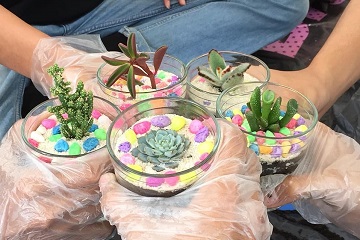Tips on Making Good Quality Tempe and Terrarium

Several students of IPB University (IPB) and other universities in Jabodetabek participated in Biofarm in Biology Department, Faculty of Mathematics and Natural Sciences, IPB University (FMIPA-IPB), on Sunday (24/2). This event is a form of biology implementation in real life, by facilitating students to study about plant breeding and cultivation. “This year’s Biofarm highlights on biodiversity while carrying on the theme about making terrarium and tempe,” said Ananda Zahra, the Head Convener of this event.
Terarrium is a method of plant cultivation using clear/transparent container. Usually, the plants used are succulents because of their unique appearances. The media used are usually zeolites, succulents, planting medium, and decorative stones. Recycled plastic cups can be used for the container to reduce plastic waste. Besides for plant cultivation, creating terrarium is also proven to reduce stress,” said Suci Pratiwi, final year student of IPB Biology Department who was the speaker of the session about terrarium.
During this occasion, Suci also said that to prevent decaying, it’s wiser to water the plants accordingly, not too much. The zeolites, which absorb water, can function as an indicator for water content in planting medium. That’s why the zeolites are placed at the bottom of the container. When they are wet, zeolites are dark green in color, which indicates that there’s no need to water the terrarium. The watering of the terrarium is done 2-3 times per week by sprinkling the water directly at the medium. Sprinkling the water at the plant will accelerate the decaying of the leaves.
“Succulents have adapted to thrive in dry environment, so water is the main threat to the terrarium. If the plant breeds, don’t forget to relocate the offspring to a new container so that it’s roots develop well,” explained Suci.
Succulents have to be put outside the room to get adequate fresh air and sunlight. “In my experience, if placed outside, the plant’s color tend to be dark green, while placing it inside while fade the color slightly. It has to be put outdoor at least once per week,” explained Suci.
Tempe-making session was carried out by Siman from ‘Super Tempe Healthy House’. Siman explained that the process of making tempe is started by boiling the soybeans, then soaking the beans with biofresh or the water used to boil the previous batch, processing the soybean until the administration of yeast. Before administering the yeast, the soybeans are washed with clean water, poured with boiling water, and sorted. The soaking has the purpose to acidify the soybeans, to ensure that the tempes wouldn’t taste bitter. For the first batch, biofresh is used, but afterwards the soaking can use the water used from the previous batch instead.
To make tempe, yeast exclusively used for tempe is needed. Five kilograms of soybeans need 10 grams of yeast. The administration of yeast can’t be done outdoors because of yeast’s tendency to scatter everywhere. Siman explained that tempes wrapped in both leaves and plastics originally used plastics at the early packaging process, with an exception of mendoan tempe, which uses leaves from the early process. Leaf-wrapped tempes were wrapped in leaves when they were half-done. “Leaf-wrapped tempes have a unique aroma because the yeast is still growing and the scent from the leaf affects the tempe,” explained Siman.
The event which has the jargon ‘Biodiversity starts here, Biofarm create your tempe and grow up terrarium’ in its execution also aims to improve students’ soft skills. “Even though biology is a basic science but we never know about our future. Soft skills like this is has many applications in the future. Hopefully the knowledge from today’s event may inspire the participants to become entrepreneurs,” said Muhimat, President of Biology Students Organization of IPB. (Ard)


